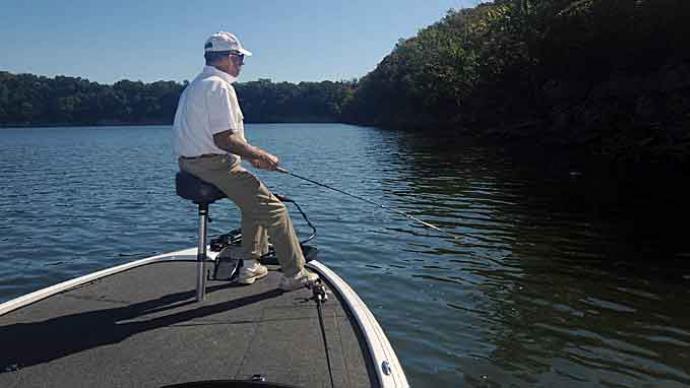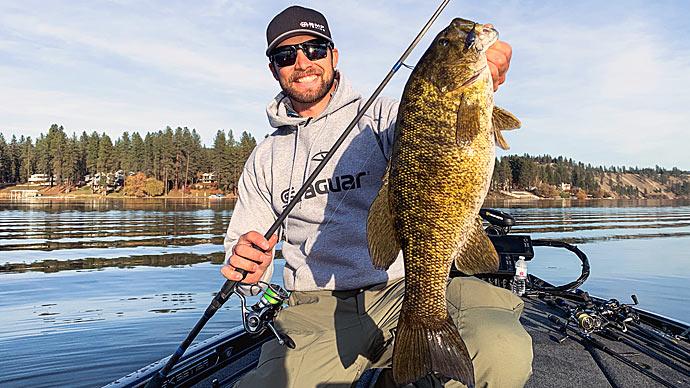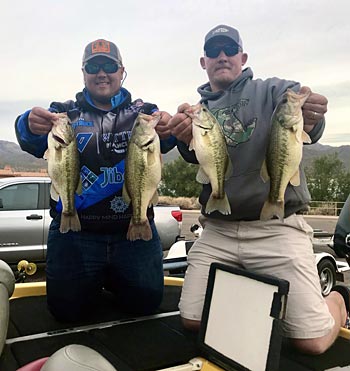
Levi Wittrock recently graduated from Northern Arizona University, where he was the president of the NAU Bass Fishing Club for two years. He and his partner represented NAU at many tournaments during those two years – tournaments that were piggy-backed onto FLW and BASS tournaments, using the same stage and the same crew. “The opportunities were insane,” Levi says, “because you get to meet so many of the big names – not just the tournament anglers, but also industry reps and the people who run the tournaments.” He says that FLW and BASS worked hard to make their weigh-ins a big show, just like the pro’s events, even though their entry fees were generally in the $75 range. It was an opportunity that allowed him to grow exponentially as a fisherman. Now he lives in Iowa and works for Pure Fishing.
Levi’s Go-To Bait Pre-Spawn Til Late Fall
If there is one bait that Levi has learned to love more than any other, it’s a Chatterbait. “The Chatterbait catches numbers, but it will also catch giants, better than any other bait I throw,” he says. His favorite by far is the Chatterbait® JackHammer™ in color BHite Delight, a green pumpkin with a chartreuse tint to the underside of the skirt. He adds a green pumpkin Yamamoto Zako to it. He says that colors catch fishermen as much as they catch fish, but he has a lot of confidence in that BHite Delight and the Green Pumpkin JackHammer.
The JackHammer is not a cheap lure – they are $15.99 on the Z-Man website. But Wittrock insists they are worth the outlay because they start vibrating as soon as they hit the water and move erratically from side to side even before you add action via the rod tip. They also skip quickly and are armed with Gamakatsu heavy wire flippin’ hooks. Also, the double wire trailer keeper holds even the soft Zako in place.
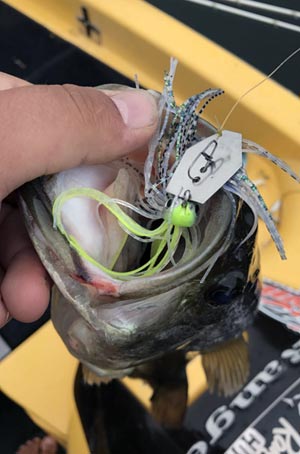
The Gear
Wittrock’s rod of choice is a glass or as close to glass Dobyn’s Rod as he can get. The parabolic bend that these rods have when they load up contributes to the action of the Chatterbait as well as the hookset. “Seriously, a fiberglass rod will double your hook ratio right out of the gate,” he insists. “On a glass rod, when you’re ripping through grass and a fish snatches it, the rod loads up and assists the hookset – you can almost just lean back and reel to set the hook.”
Much of his gear was bought when he was a starving student, so he’s the master of getting a lot of bang for his buck. An example is a reel he uses with Chatterbaits: the Diawa Tatula. He says it holds plenty of line, doesn’t cost a fortune, and performs excellent. He likes the faster reel so he can burn the bait when he needs to or catch up quick if a fish slams it and heads right toward him. He spools it with 16-pound Sunline Sniper Fluorocarbon and uses a Palomar knot to tie on the bait.
Technique: Prespawn Through Post-Spawn
Levi’s favorite places to fish this time of year are grass flats or coves with some grass. As soon as the water temperature gets into the 50s, he throws a Chatterbait and keeps throwing it all through summer. He throws right up to shore and almost right back into any reeds. “I start shallow and quick,” he says, “just straight cranking til I feel the grass, then ripping it out.” He says that straight cranking will catch some, but he gets a lot more bites when he rips the bait now and then. On rocks, he’ll jig, hop, or jerk the Chatterbait, giving it action by moving the rod tip. If he isn’t getting bit, he’ll move out deeper.
“If I’m not getting bit or not getting good bites, I move out before I move on,” he says. He’ll cover the entire cove, switching areas or colors or depths until he starts getting the bites he wants. As a rule, he doesn’t slow up. He covers water. The exception is post-spawn.
Post-spawn through early summer, if his usual quick reeling isn’t working, he’ll cast the Chatterbait out and let it hit bottom, then drag it so slowly that he can barely feel the blade. Sometimes he’ll park in the middle of the cove and slow-roll it like that, dragging it clear out to the boat, up to fifteen feet deep. Typically, though, he sticks to fishing to ten feet or so. He says the bass may be guarding fry at this time, and they hammer it, mainly if you use the BHite Delight, which looks like bluegill. He also dresses the bait with a white or chartreuse Zako post-spawn to brighten it up. It takes a lot of casts this time of year – he covers the same piece of water multiple times at multiple angles. It’s not as fast, but it’s effective. When you get this post-spawn fry-guarding bite, he says, it’s not “was that a fish?”, it’s “hang on to the rod!”.
Spook Fishing
“I’m addicted to walking baits,” says Levi, “I like them all, but by far, my favorite is the Heddon Super Spook in Lake Fork Shad.” When the water is flat, and the sun is out, he’ll throw this bait from spawn until it starts to get cold in the winter. “I’ll be throwing a Spook when everyone else is drop-shotting,” he says. Spooks flat catch big fish. He’ll fish good spots multiple days a day, especially spots with easy access to deep water. Those places where fish will move up and down during the day, and you have to be there when they’re up.
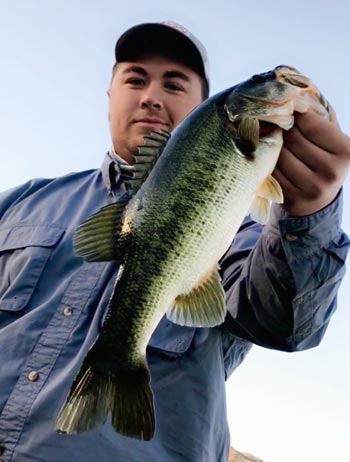
Levi likes to cast to targets – against the shore and right up next to the bank, even in six inches of water. A muggy, hot, and dead calm day makes the perfect conditions for Spook fishing. Grass edges are fantastic, he says. When he and his partner were fishing a grass edge at Clear Lake with Spooks, their sack went from twelve pounds to twenty-two pounds in less than fifteen minutes. His partner was catching the fish, and Levi had all he could do to keep up with him, culling fish and not even trying to weigh them.
Gear
He says that Wittrock fishes Spooks on an extra-heavy 7’4” or 7’6” rod – basically a flippin’ stick. A big stout rod with bait as heavy as a Spook lets you make incredibly long casts and makes it easier to fish the Spook around cover because you have the power to horse it out of almost anything. You don’t have to set hard with a Spook, especially when you switch all the hooks out to EWG Gamakatsu trebles as Levi does. “They come with pretty good hooks right out of the box, but Gamakatsu hooks are hard to beat,” he explains. With nine incredibly sharp hooks per bait, it’s unlikely the fish will get off once he bites.
He fishes Spooks on 65-pound Daiwa J Braid and ties them on with a Palomar knot. You need a BIG loop to tie a Spook on with a Palomar, but he loves that the Palomar gives you twice as much line through the eye. He says you don't have to worry about the braid coming untied if you cut the tag end a little longer than you usually would. It may slip a tiny bit on the first fish, but it settles in. The braid means everything about his Spook fishing is quick – casting, beginning to walk and setting the hook. Now and then, he’ll play around with cadence, but most of the time, it’s just straight Walking the Dog. Because he puts most of the action on the bait with the rod, the reel isn’t as important, but he uses at least a 7.3:1 reel because he needs to catch up to the bait when a fish slams it. Most of the fish he’s lost have been because he couldn’t catch up, and they let go before he could put any pressure on them.
College Fishing
The Bass Fishing Club is the Bass Fishing Team at Northern Arizona University. But since Bass Fishing is not an NCAA-recognized sport, they call it a club. However, the university does reimburse the club for some expenses each year -- for a single team. Levi and his partner were the only members who owned a boat, so they went to the tournaments to represent NAU. Arizona State University is much bigger, and they have five teams.
Levi said that companies like Dobyns’ Rods, Johnson Outdoors, Yamamoto Custom Baits, and Habit Outdoors sponsored them with discounts and products that helped them out, being on such a tight budget. They did a tournament on the Potomac River, and that trip is pretty steep for a couple of college kids. He said he learned a couple of big lessons from that trip: don’t go through Nashville at 5:25 pm towing a boat, and don’t go through D.C at any time towing a boat.
He says that the experience of fishing in the College tournaments was worth it all. The payouts weren’t a lot of money, but they helped defray expenses. The actual payout is that the Qualifiers can take you to the National Championship, and if you win that, you go to the Forrest Wood Cup or the Bassmaster Classic, depending on which circuit you were piggy-backed on. College Teams are hard work for very little recognition, so show them some love if you have one nearby.
BassResource may receive a portion of revenues if you make a purchase using a link above.


